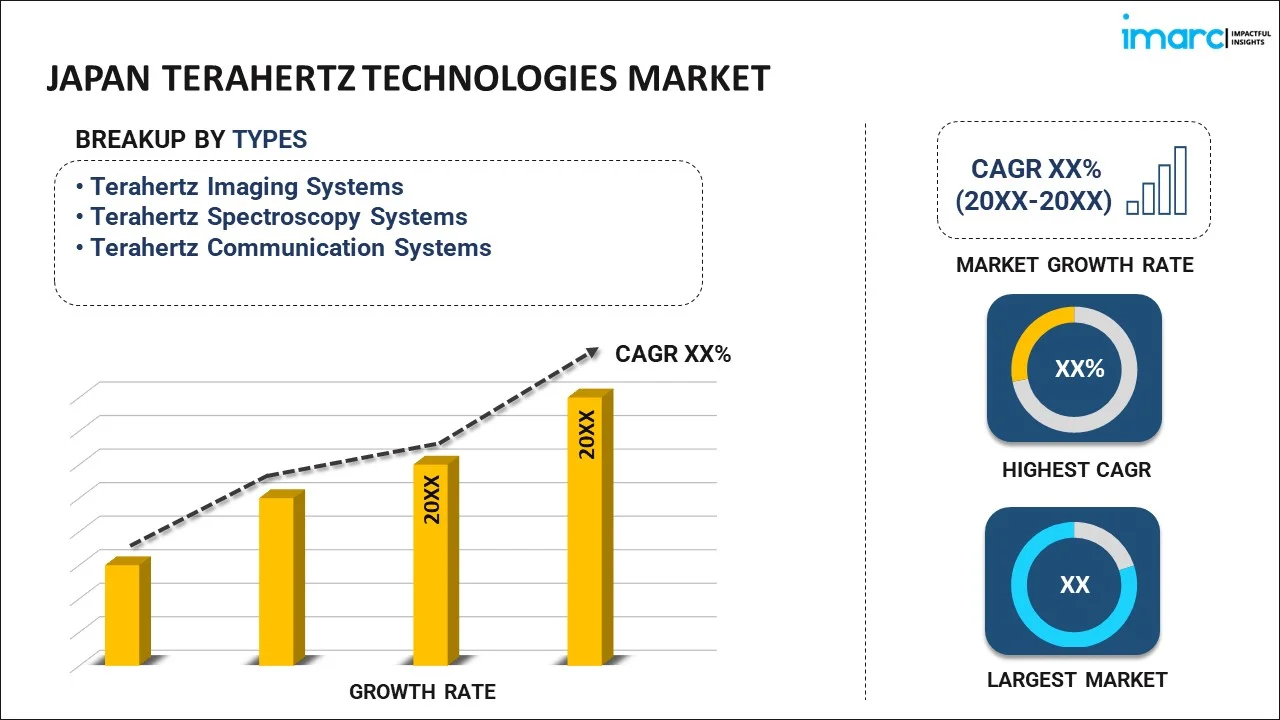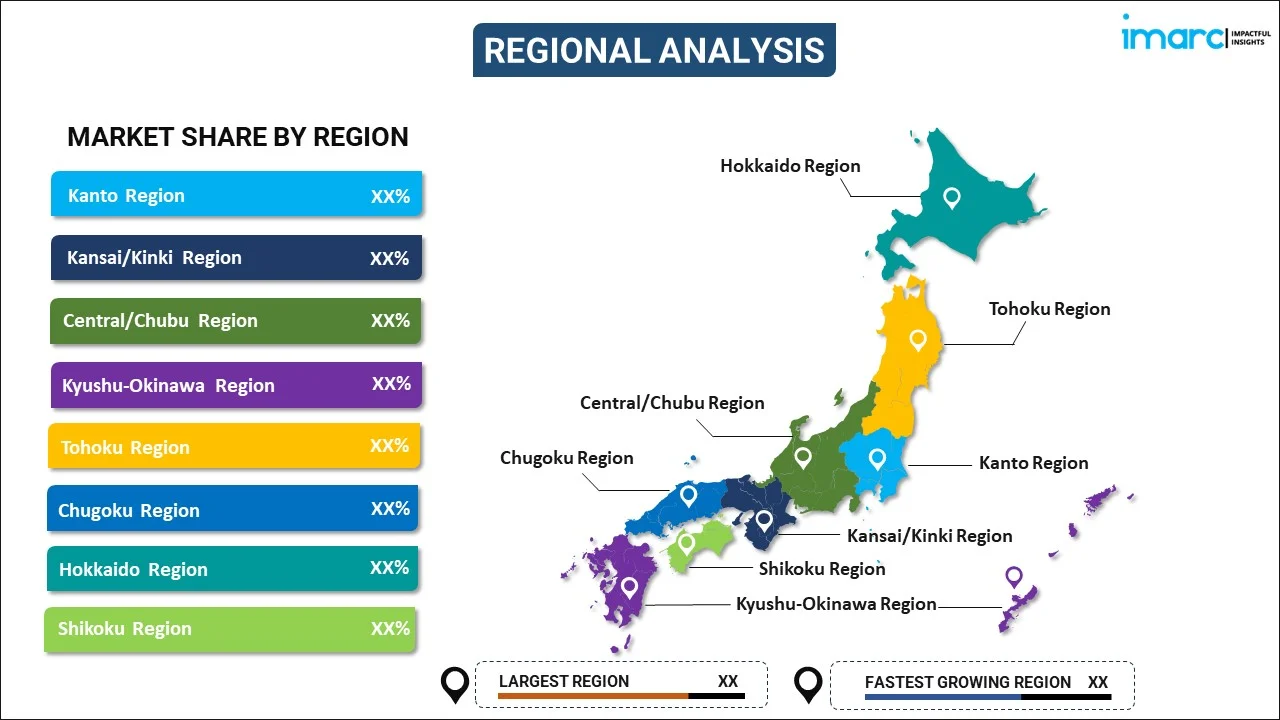
Japan Terahertz Technologies Market Report by Type (Terahertz Imaging Systems, Terahertz Spectroscopy Systems, Terahertz Communication Systems), Component (Terahertz Sources, Terahertz Detectors), End Use Industry (Healthcare and Medical, Defense and Security, Telecommunications, Food and Agriculture, and Others), and Region 2025-2033
Market Overview:
Japan terahertz technologies market size reached USD 53.6 Million in 2024. Looking forward, IMARC Group expects the market to reach USD 347.9 Million by 2033, exhibiting a growth rate (CAGR) of 21.38% during 2025-2033. The growing investments in wireless telecommunication systems, along with the rising concerns among government bodies towards public safety and product quality, are primarily driving the market growth.
|
Report Attribute
|
Key Statistics
|
|---|---|
|
Base Year
|
2024 |
|
Forecast Years
|
2025-2033
|
|
Historical Years
|
2019-2024
|
| Market Size in 2024 | USD 53.6 Million |
| Market Forecast in 2033 | USD 347.9 Million |
| Market Growth Rate (2025-2033) | 21.38% |
Terahertz (THz) technologies rely on electromagnetic radiation situated within the spectrum between infrared radiation (IR) and microwaves. These technologies possess the unique ability to penetrate a wide range of materials, including clothing, paper, wood, plastic, ceramics, cardboard, masonry, enclosures, and various opaque substances, all without causing any harm or damage. THz technologies offer the advantage of producing high-resolution images and facilitating rapid data transmission. Additionally, their low-energy characteristics render them non-destructive and non-invasive, making them inherently safe for humans, animals, and plants when compared to X-rays and near-infrared radiation (NIR). Consequently, THz technologies are extensively employed in diverse applications, particularly within the pharmaceutical industry, where they play a crucial role in performing non-destructive and internal chemical analyses of tablets, capsules, and other pharmaceutical dosage forms.
Japan Terahertz Technologies Market Trends:
The Japan terahertz technologies market is experiencing robust growth, driven by a multitude of factors. One significant catalyst is the extensive utilization of THz radiation across various sectors, both domestically and globally. In the food and beverage (F&B) industry, for example, THz radiation plays a pivotal role in conducting non-destructive analysis (NDT) of sealed packages, ensuring product quality and safety. Furthermore, stringent regulations imposed by governments worldwide concerning public safety and product quality have had a positive impact on the market. The emphasis on compliance with these regulations has led to increased adoption of THz technologies to meet regulatory requirements. Moreover, the rising awareness of the advantages of early diagnosis is driving the adoption of THz tomography for the early screening of conditions such as tooth decay and cancer. THz technology also finds application in visualizing wounds beneath materials like gypsum or bandages, enhancing healthcare diagnostics and treatment. The growing concerns surrounding public security have propelled the adoption of THz radiation at airports for remote screening of individuals and luggage, bolstering security measures. Additionally, THz technology is instrumental in the development of next-generation high-frequency wireless telecommunication systems, facilitating high-speed information transmission between electronic devices. Furthermore, the increasing investments aimed at creating affordable, user-friendly, and compact THz technology-based devices are expected to fuel the market growth over the forecasted period.
Japan Terahertz Technologies Market Segmentation:
IMARC Group provides an analysis of the key trends in each segment of the market, along with forecasts at the country level for 2025-2033. Our report has categorized the market based on type, component, and end use industry.
Type Insights:

- Terahertz Imaging Systems
- Active System
- Passive System
- Terahertz Spectroscopy Systems
- Time Domain
- Frequency Domain
- Terahertz Communication Systems
The report has provided a detailed breakup and analysis of the market based on the type. This terahertz imaging systems (active system and passive system), terahertz spectroscopy systems (time domain and frequency domain), and terahertz communication systems.
Component Insights:
- Terahertz Sources
- Terahertz Detectors
A detailed breakup and analysis of the market based on the component have also been provided in the report. This includes terahertz sources and terahertz detectors.
End Use Industry Insights:
- Healthcare and Medical
- Defense and Security
- Telecommunications
- Food and Agriculture
- Others
The report has provided a detailed breakup and analysis of the market based on the end use industry. This includes healthcare and medical, defense and security, telecommunications, food and agriculture, and others.
Regional Insights:

- Kanto Region
- Kansai/Kinki Region
- Central/ Chubu Region
- Kyushu-Okinawa Region
- Tohoku Region
- Chugoku Region
- Hokkaido Region
- Shikoku Region
The report has also provided a comprehensive analysis of all the major regional markets, which include Kanto Region, Kansai/Kinki Region, Central/ Chubu Region, Kyushu-Okinawa Region, Tohoku Region, Chugoku Region, Hokkaido Region, and Shikoku Region.
Competitive Landscape:
The market research report has also provided a comprehensive analysis of the competitive landscape. Competitive analysis such as market structure, key player positioning, top winning strategies, competitive dashboard, and company evaluation quadrant has been covered in the report. Also, detailed profiles of all major companies have been provided.
Japan Terahertz Technologies Market Report Coverage:
| Report Features | Details |
|---|---|
| Base Year of the Analysis | 2024 |
| Historical Period | 2019-2024 |
| Forecast Period | 2025-2033 |
| Units | Million USD |
| Scope of the Report | Exploration of Historical and Forecast Trends, Industry Catalysts and Challenges, Segment-Wise Historical and Predictive Market Assessment:
|
| Types Covered |
|
| Components Covered | Terahertz Sources, Terahertz Detectors |
| End Use Industries Covered | Healthcare and Medical, Defense and Security, Telecommunications, Food and Agriculture, Others |
| Regions Covered | Kanto Region, Kansai/Kinki Region, Central/ Chubu Region, Kyushu-Okinawa Region, Tohoku Region, Chugoku Region, Hokkaido Region, Shikoku Region |
| Customization Scope | 10% Free Customization |
| Post-Sale Analyst Support | 10-12 Weeks |
| Delivery Format | PDF and Excel through Email (We can also provide the editable version of the report in PPT/Word format on special request) |
Key Questions Answered in This Report:
- How has the Japan terahertz technologies market performed so far and how will it perform in the coming years?
- What has been the impact of COVID-19 on the Japan terahertz technologies market?
- What is the breakup of the Japan terahertz technologies market on the basis of type?
- What is the breakup of the Japan terahertz technologies market on the basis of component?
- What is the breakup of the Japan terahertz technologies market on the basis of end use industry?
- What are the various stages in the value chain of the Japan terahertz technologies market?
- What are the key driving factors and challenges in the Japan terahertz technologies?
- What is the structure of the Japan terahertz technologies market and who are the key players?
- What is the degree of competition in the Japan terahertz technologies market?
Key Benefits for Stakeholders:
- IMARC’s industry report offers a comprehensive quantitative analysis of various market segments, historical and current market trends, market forecasts, and dynamics of the Japan terahertz technologies market from 2019-2033.
- The research report provides the latest information on the market drivers, challenges, and opportunities in the Japan terahertz technologies market.
- Porter's five forces analysis assist stakeholders in assessing the impact of new entrants, competitive rivalry, supplier power, buyer power, and the threat of substitution. It helps stakeholders to analyze the level of competition within the Japan terahertz technologies industry and its attractiveness.
- Competitive landscape allows stakeholders to understand their competitive environment and provides an insight into the current positions of key players in the market.
Need more help?
- Speak to our experienced analysts for insights on the current market scenarios.
- Include additional segments and countries to customize the report as per your requirement.
- Gain an unparalleled competitive advantage in your domain by understanding how to utilize the report and positively impacting your operations and revenue.
- For further assistance, please connect with our analysts.
 Inquire Before Buying
Inquire Before Buying
 Speak to an Analyst
Speak to an Analyst
 Request Brochure
Request Brochure
 Request Customization
Request Customization




.webp)




.webp)












